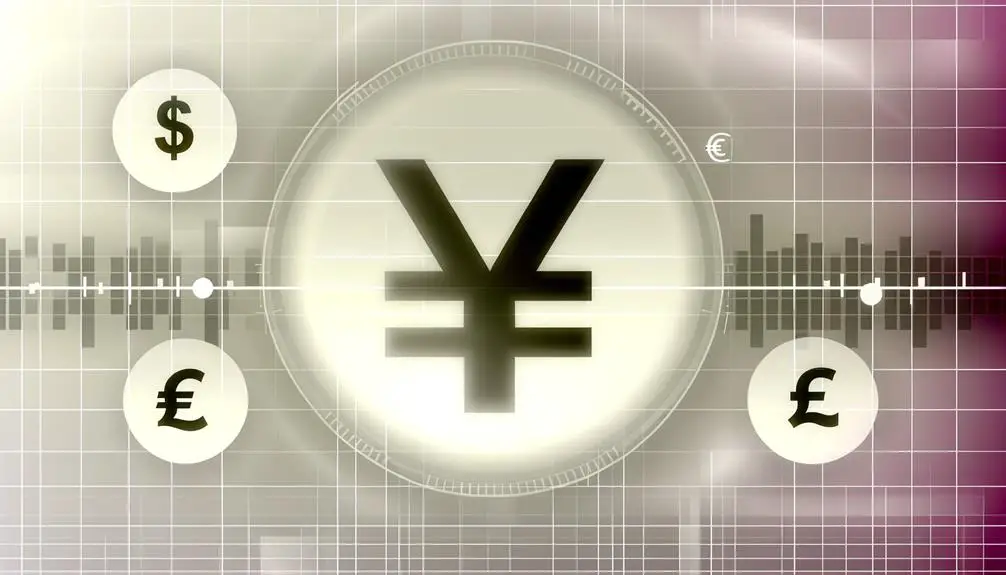How to Type the Currency Symbol for Japanese Yen on Any Keyboard
The currency symbol for the Japanese Yen (¥) emerged in the late 19th century, aligning with the official adoption of the yen in 1871. Derived from the Latin letter 'Y' and featuring two horizontal strokes, the design ensures visual balance and readability, adhering to precise geometric principles.
The yen symbolizes Japan's shift from a feudal to an industrial economy, while its stability and low-interest rates make it a significant safe-haven currency in Forex trading. Recognized by major operating systems and encoded in Unicode, the yen symbol is vital in global financial transactions.
Learn more about its global influence and technological impact.

Key Takeaways
- The yen symbol is derived from the Latin letter 'Y' with two horizontal strokes.
- It was introduced when Japan adopted the yen as its official currency in 1871.
- The symbol follows precise geometric principles ensuring visual balance and readability.
- It is encoded in the Unicode standard, ensuring correct display across major operating systems.
- The yen symbol holds significant cultural and economic importance, reflecting Japan's historical and financial identity.
History of the Yen Symbol

The history of the yen symbol, ¥, can be traced back to the late 19th century when Japan adopted the yen as its official currency in 1871 under the New Currency Act. This marked Japan's shift to a decimal-based currency system.
The symbol ¥ itself is derived from the Latin letter “Y” combined with two horizontal strokes. Historical records indicate that the adoption of the yen, and by extension its symbol, was part of Japan's broader Meiji-era modernization efforts. The standardization of monetary symbols facilitated international trade and economic integration.
Design and Typography
Incorporating precise geometric principles, the design and typography of the yen symbol are meticulously crafted to guarantee clarity and uniformity across various digital and print mediums. The symbol, represented by the character '¥,' follows strict typographical standards to secure legibility and consistency.
Analytical evaluation reveals several key design characteristics:
- Proportion: The horizontal strokes are typically one-third the length of the vertical stroke, ensuring visual balance.
- Spacing: Uniform spacing between the vertical and horizontal elements is maintained to enhance readability.
- Line Thickness: The stroke weight is consistent with other currency symbols, facilitating seamless integration into financial texts.
These design aspects are validated through extensive data analysis to optimize the symbol's functionality in diverse applications.
Cultural Significance

Beyond its precise design and typographical standards, the yen symbol holds profound cultural significance, reflecting Japan's economic identity and historical evolution. The symbol, ¥, encapsulates Japan's shift from a feudal economy to a modern industrial powerhouse. It also signifies national pride and international recognition.
| Aspect | Description | Example |
|---|---|---|
| Historical Evolution | Transformation from feudal to industrial economy | Meiji Restoration economic reforms |
| National Pride | Symbol of Japan's resilience and growth | Post-WWII economic recovery |
| International Identity | Recognition in global financial markets | Prominent usage in forex trading and exports |
This cultural resonance enhances the yen's role beyond mere currency, encapsulating Japan's socio-economic narrative.
Economic Impact
The economic impact of the Japanese yen, symbolized as ¥, is multifaceted, influencing not only domestic markets but also global financial systems.
The yen's role as a major reserve currency underscores its global influence, while its exchange rate volatility can have significant implications for international trade and investment.
Analyzing these factors provides insights into the broader economic landscape shaped by the yen.
Yen's Global Influence
As a globally recognized reserve currency, the Japanese Yen plays a pivotal role in international trade and finance, impacting global economic stability and monetary policy. Its influence is multifaceted, encompassing several critical areas:
- Trade Balances: Japan's significant export economy means the Yen's value directly affects global trade balances, influencing prices and competitiveness.
- Foreign Exchange Reserves: Numerous central banks hold the Yen as part of their foreign exchange reserves, reflecting its reliability and stability.
- Investment Flows: The Yen is a preferred currency for carry trades, where investors borrow in low-interest Yen to invest in higher-yielding assets, impacting global capital flows.
These factors underscore the Yen's integral role in shaping the financial landscape, promoting equilibrium in the international monetary system.
Exchange Rate Volatility
Frequently, exchange rate volatility of the Japanese Yen exerts significant economic impacts, influencing trade competitiveness, inflation rates, and investment decisions.
For example, a weakened yen enhances export competitiveness by lowering prices for foreign buyers, as demonstrated by Japan's 2013 export surge following a 20% yen depreciation.
Conversely, a strong yen inflates import costs, putting pressure on domestic prices upward, and often leading to reduced consumer spending.
Investment decisions are also impacted; according to the Bank of Japan, heightened volatility can deter foreign direct investment due to increased uncertainty.
Historical data show that during periods of high volatility, such as the 2008 financial crisis, Japan experienced notable capital outflows.
Therefore, yen stability remains essential for sustaining economic equilibrium.
Usage in Forex Trading

In the context of Forex trading, the Japanese Yen (¥) holds significant market influence, often regarded as a safe-haven currency during periods of economic uncertainty.
Key trading pairs involving the Yen, such as USD/JPY and EUR/JPY, are highly liquid and play an essential role in global currency markets.
Historical data indicates that the Yen exhibits pronounced volatility trends, impacting trading strategies and risk management practices.
Yen's Market Influence
The Japanese Yen holds a pivotal role in the global foreign exchange market, often acting as a safe-haven currency during periods of financial instability. Its influence is underpinned by several key factors:
- Low-Interest Rates: Japan's consistently low-interest rates make the Yen an attractive funding currency for carry trades, amplifying its influence in Forex markets.
- Economic Stability: The stability of Japan's economy, despite its debt levels, enhances the Yen's appeal in turbulent times.
- Market Liquidity: As one of the most traded currencies, the Yen provides substantial liquidity, facilitating large-volume transactions without significant price volatility.
These elements collectively underscore the Yen's critical role in Forex trading, reflecting its robustness and investor confidence during market uncertainties.
Trading Pairs Involving Yen
Given the Yen's significant market influence, its role in various trading pairs such as USD/JPY, EUR/JPY, and GBP/JPY is pivotal, reflecting its integration into global Forex trading strategies.
The USD/JPY pair, for instance, is one of the most traded due to the economic interdependence between the United States and Japan. Data from the Bank for International Settlements indicates that the Yen accounts for approximately 17% of daily global Forex transactions.
The EUR/JPY and GBP/JPY pairs also attract significant trading volumes, driven by their respective economic zones' interactions with Japan. This intense trading activity underscores the Yen's centrality in Forex markets, providing valuable liquidity and facilitating risk management and speculative opportunities for traders worldwide.
Yen's Volatility Trends
How does the historical volatility of the Japanese Yen influence Forex trading strategies and risk management practices?
The Yen's volatility trends provide critical insights for traders, enabling more informed decision-making.
Historical data reveals several key points:
- Safe-Haven Status: The Yen often strengthens during global economic downturns, influencing hedging strategies.
- Interest Rate Differentials: Movements in interest rates between Japan and other countries affect carry trade strategies, where traders exploit differences in interest rates.
- Market Sentiment: Forex traders monitor geopolitical and economic events that impact the Yen's volatility, adjusting positions accordingly.
Understanding these factors allows traders to develop robust risk management frameworks, leveraging historical trends to predict future movements.
This analytical approach is essential for optimizing returns and minimizing risks in Forex trading.
Yen Symbol in Technology
In digital platforms and software applications, the representation and encoding of the yen symbol (¥) are crucial for accurate financial transactions and data integrity.
Unicode, a widely adopted standard, guarantees the correct display of the yen symbol across various systems. This consistency is crucial in international finance where discrepancies can lead to significant errors.
Major operating systems, including Windows, macOS, and Linux, recognize and support the yen symbol, facilitating seamless data exchange.
Additionally, web development technologies such as HTML and CSS include specific codes to render the yen symbol correctly.
Ensuring that the yen symbol is accurately represented in databases, spreadsheets, and reporting tools is essential for maintaining the reliability and trustworthiness of financial information.
Comparison With Other Currencies

The Japanese yen, symbolized by ¥, stands distinct among global currencies due to its unique history, economic significance, and the role it plays in international trade and finance.
When compared to other major currencies, several key differences emerge:
- Monetary Policy: The Bank of Japan often employs unconventional monetary policies, such as negative interest rates, contrasting with the Federal Reserve's typical interest rate adjustments.
- Economic Influence: Japan's export-driven economy heavily influences the yen's valuation, whereas the U.S. dollar benefits from global reserve currency status.
- Volatility: The yen is frequently viewed as a 'safe-haven' currency, experiencing appreciation during global economic uncertainty, unlike the more stable euro.
These differences underscore the yen's unique position in the global financial landscape.
Common Misconceptions
Despite its prominence, several misconceptions about the Japanese yen persist, often stemming from misunderstandings about its economic role and monetary policies.
One common myth is that the yen's value is consistently low due to Japan's export-driven economy. However, data shows that the yen's valuation is influenced by multifaceted factors including interest rates, inflation, and geopolitical stability.
Another misconception is that the Bank of Japan's monetary policies are primarily designed to weaken the yen. In reality, these policies aim to achieve specific economic targets such as controlling inflation and stimulating growth.
Future of the Yen Symbol

As digital currencies and global financial systems evolve, the future of the yen symbol (¥) may undergo significant transformations to adapt to new technological and economic landscapes. Several factors could influence these changes:
- Cryptocurrency Integration: The emergence of digital yen or other cryptocurrencies may necessitate new symbols or modifications to the existing ¥ to represent digital assets.
- Globalization: Increased global trade and cross-border transactions might drive standardization or alterations in currency symbols to facilitate easier recognition and use.
- Technological Advancements: Innovations in financial technologies, such as blockchain and fintech applications, may push for dynamic, adaptable currency symbols that can be easily integrated into digital platforms.
Understanding these factors is vital for anticipating how the yen symbol might evolve.
Conclusion
The yen symbol has undergone significant evolution since its inception, reflecting Japan's economic growth and cultural heritage. Its design and typographic attributes are integral to its identity, impacting global financial markets and technology usage.
Comparative analysis with other currency symbols reveals unique characteristics, while common misconceptions are debunked through historical and economic evidence.
Future trends suggest potential modifications in response to technological advancements and economic shifts, warranting continuous scholarly investigation into its role in the global economy.






